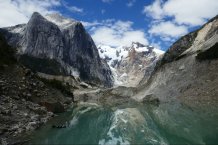Articles

Credit: Stephan Harrison
Glacial lakes 50 per cent bigger since 1990
The amount of water in glacial lakes worldwide has risen by about 50 per cent since 1990, researchers say.
Glaciers are retreating due to global warming, and the new study shows the resulting lakes have grown dramatically.
Some water from melting glaciers flows straight into oceans, but a substantial amount feeds glacial lakes – and communities downstream now face an increased threat of devastating floods.
The international research team – led by the University of Calgary and including Professor Stephan Harrison and Professor Richard Betts from the University of Exeter – used satellite data from NASA and Google Earth Engine to analyse all of the world’s glacial lakes.
Professor Richards Betts, of the University of Exeter's Global Systems Institute and Head of Climate Impacts Research at the Met Office, said: "This research adds an important new piece to the jigsaw in our understanding of the role of melting ice in the global water cycle. Six years ago, the IPCC 5th Assessment Report highlighted glacial lakes as a key knowledge gap. By addressing that gap, we are improving our knowledge of how climate change is affecting water resources and sea level rise by driving glacier retreat.”
The models used to date by the Intergovernmental Panel on Climate Change (IPCC) to translate glacier melt into sea-level change assume that water from glacier melt is instantaneously transmitted to the oceans.
However, the study found that the volume of water in glacial lakes has increased about 50% since 1990, currently totalling approximately 156 cubic kilometres of water.
Glacial lakes, which are often dammed by ice or glacial sediment called a moraine, can be quite unstable and they can burst their banks or dams, causing massive floods downstream.
These floods, also known as glacial lake outburst floods (GLOFs), have been responsible for thousands of deaths over the last century, as well as the destruction of villages, infrastructure and livestock.
Professor Stephan Harrison from Exeter’s College of Life and Environmental Sciences, said: “Assessing the behaviour and evolution of the world’s glacial lakes helps us understand the risks of catastrophic hazards such as glacial lake outburst floods that have killed tens of thousands of people in high mountain regions over the past few decades”.
A recent GLOF affected the Hunza Valley in Pakistan in May 2020.
"The issue is for many parts of the world where people live downstream from these hazardous lakes, mostly in the Andes and in places like Bhutan and Nepal, where GLOFs can be devastating," added lead author Dr Dan Shugar, of the University of Calgary.
"Fortunately, organisations like the UN are doing or facilitating a lot of monitoring work and some mitigation work where they’re lowering the lakes to try and decrease the risks.
"Since we don’t have much in the way of infrastructure or communities that are downstream, the chances of a GLOF having major impacts in North America are fairly low. But we’re not immune to it."
The paper, published in Nature Climate Change, is entitled: "Rapid worldwide growth of glacial lakes since 1990 ."
Date: 31 August 2020
